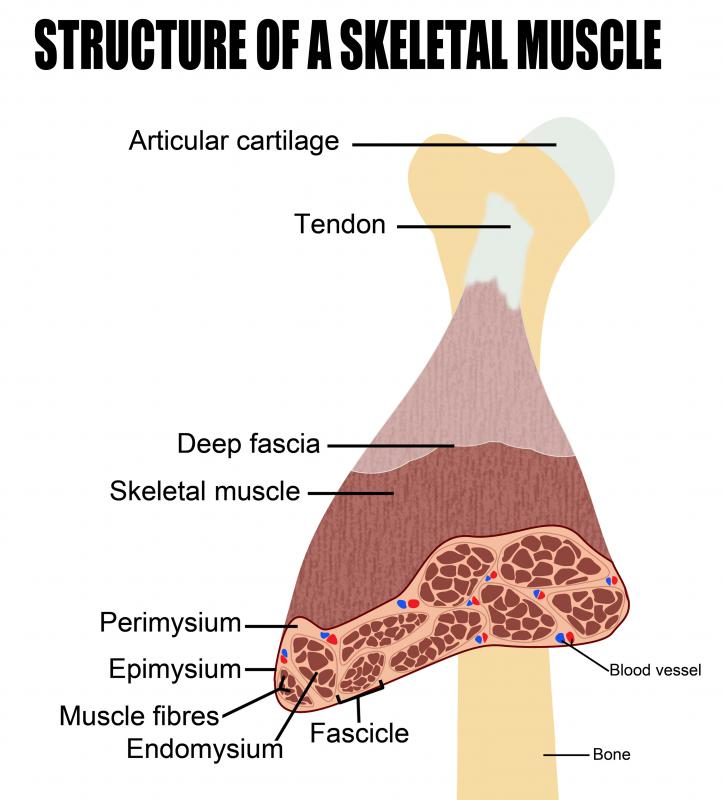At TheHealthBoard, we're committed to delivering accurate, trustworthy information. Our expert-authored content is rigorously fact-checked and sourced from credible authorities. Discover how we uphold the highest standards in providing you with reliable knowledge.
What is Perimysium?
Perimysium is a membrane that protects and supports groups of fibers within skeletal muscle. Together with other supporting membranes, the perimysium is responsible for shaping and organizing the muscle fibers, as well as transmitting forces within the muscle. Connective tissue, including the supporting membranes, as well as the tendons, is estimated to make up roughly 15% of the mass of an individual muscle.
Typically, perimysial tissue is comprised of collagen and elastin fibers embedded in a mucopolysaccharide base. Collagen fibers give the tissue strength, while the elastin fibers, not surprisingly, promote elasticity. The base material acts as both glue and lubricant, simultaneously holding the structure together and allowing the fibers to move easily against one another.

Most mammals have three types of muscle tissue — cardiac, skeletal, and smooth. Human skeletal muscle, which attaches to the bones and is responsible for their movement, makes up the highest proportion of muscle tissues in the body. This type of muscle tissue is distinguished from the other two in a number of ways, not the least of which being its hierarchy of organization. Muscle components are grouped into increasingly complex structures, bound and supported by connective tissue.

Each muscle fiber is a single cell, covered by a gossamer membrane known as the endomysium. Muscle fibers are grouped into bundles, known as fascicles, which are encased by the perimysium. Each fascicle typically contains about 100 to 150 muscle fibers, with a wide degree of variation. Numerous fascicles together make up the muscle belly, which is wrapped in a tough, membranous coating known as the epimysium. The endomysium, perimysium, and epimesium together are known as the fascia of the muscle.

Like the muscle itself, the collagen and elastin fibers of the perimysium appear to have a three-tiered structure, with each level of organization built upon the one before it. Coarse, crimped fibers run lengthwise as well as circularly, encasing the entire fascicle like a fishnet stocking. Branching out from this framework, numerous uncrimped collagen fibrils form a loose, delicate sheath that covers all of the fascicle surface. Finally, fine bundles of fibrils attach adjacent muscle fibers to each other, and to the endomysium, using minute structures known as perimysial junction plates.

The muscle fascia provides a framework that supports the muscle fibers and protects them from damage due to over-stretching. At rest, most of the perimysial fibers lay at about a 60 degree angle to the muscle fibers. When the muscle is stretched, these fibers lose their crimped appearance and the angle decreases to follow the line of force. In this way, the perimysium absorbs and distributes forces, reducing stress to the muscle fibers. When the external force is removed, the fascia allows the muscle fibers to regain their original orientation.

In addition to providing structure and support, the perimysium can create pathways within the muscle. Running between the fascicles, the perimysium forms tunnels of connective tissue, known as the intramuscular septa. These conduits accommodate the arterioles, venules, and nerves that service the muscle.
An increase in muscular connective tissue is associated with both aging and inactivity. Over time, the proportion of elastin to collagen fibers within the fascia decreases, as does the degree of lubrication provided by the mucopolysaccharide base. Thus, aging and inactivity are often associated with an overall loss of flexibility. This trend can usually be slowed or reversed by regular flexibility exercises, such as yoga, Pilates, or simple daily stretching.
AS FEATURED ON:
AS FEATURED ON:















Discuss this Article
Post your comments